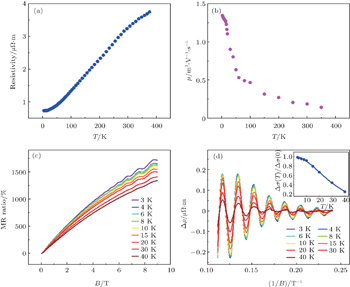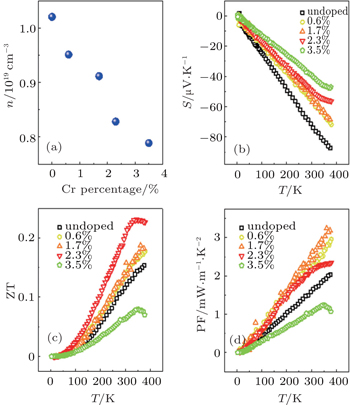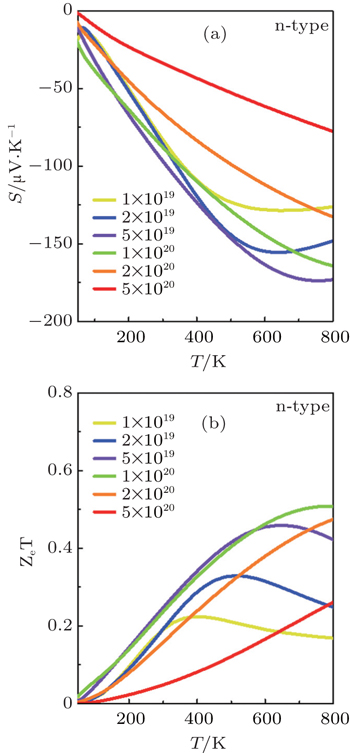† Corresponding author. E-mail:
Thermoelectrics has long been considered as a promising way of power generation for the next decades. So far, extensive efforts have been devoted to the search of ideal thermoelectric materials, which require both high electrical conductivity and low thermal conductivity. Recently, the emerging Dirac semimetal Cd 3 As 2 , a three-dimensional analogue of graphene, has been reported to host ultra-high mobility and good electrical conductivity as metals. Here, we report the observation of unexpected low thermal conductivity in Cd 3 As 2 , one order of magnitude lower than the conventional metals or semimetals with a similar electrical conductivity, despite the semimetal band structure and high electron mobility. The power factor also reaches a large value of 1.58 mW·m −1 ·K −2 at room temperature and remains non-saturated up to 400 K. Corroborating with the first-principles calculations, we find that the thermoelectric performance can be well-modulated by the carrier concentration in a wide range. This work demonstrates the Dirac semimetal Cd 3 As 2 as a potential candidate of thermoelectric materials.
As a clean, quiet and reliable way of power generation and refrigeration, thermoelectric (TE) phenomena are expected to play an important role in the global sustainable energy solution. [ 1 – 3 ] However, substantial challenge remains unresolved before the wide spread of thermoelectricity due to the low efficiency in heat-to-electricity conversion. [ 1 , 4 ] The TE energy conversion efficiency is evaluated by a dimensionless thermoelectric figure of merit ZT = S 2 σT / κ , where S , σ , T , and κ are the Seebeck coefficient, electrical conductivity, temperature, and thermal conductivity, respectively. One of the most fascinating approaches to design a high-performance TE material is to independently control the thermal and electrical transport. [ 1 , 2 , 5 ] Over the past several decades, extensive efforts have been devoted to this approach involving the study of low-dimensional TE materials and the exploration of phonon glass–electron crystals, aiming at lowering the thermal conductivity while maintaining the high electrical conductivity. [ 1 , 2 , 5 , 6 ]
To maximize ZT, a large Seebeck coefficient, a high electrical conductivity, and a low thermal conductivity are required. These parameters are in fact intimately coupled, providing conflicts in the optimization process. [ 2 ] For example, a high mobility leads to a high conductivity σ ; but usually it is accompanied with a high thermal conductivity κ . On the other hand, the low thermal dissipation and high electrical conductivity in large-mobility materials strike as appealing features during the energy conversion. [ 7 ] A straightforward method to overcome such a trade-off is to reduce the lattice thermal conductivity κ L by introducing the lattice disorder thus shortening the phonon mean free path. [ 7 , 8 ] But it requires the materials to preserve high mobility in the presence of lattice disorder, which is not the case for the most materials available so far. [ 8 ]
Recently, a new class of topological matter, Dirac semimetal, is theoretically predicted and experimentally realized in Cd 3 As 2 . [ 9 – 13 ] In such materials, the conduction band and the valence band intersect each other only at Dirac nodes in the momentum space, forming a semimetal band structure. [ 10 , 13 ] Similar to other Dirac materials like topological insulators, Cd 3 As 2 possesses a linear band dispersion and topological nontrivial band structure. [ 10 , 13 ] Remarkably, transport experiments revealed a hidden protection mechanism that strongly suppressed the backscattering of electrons in the absence of magnetic field, leading to an exceptionally long electron mean free path up to hundreds of micron meters at low temperatures thus holding a great prospect for the high TE performance. [ 14 , 15 ]
In this work, we report the TE properties of this newly-discovered Dirac semimetal Cd 3 As 2 . Remarkably, despite its high mobility, the thermal conductivity of Cd 3 As 2 is found to be unexpectedly low, down to 4.17 W·m −1 ·K −1 , resulting from a large phonon–phonon scattering. [ 16 ] For conventional metals or semimetals with similar electrical conductivity, the thermal conductivity is usually an order larger. [ 17 ] Benefiting from the semimetal band structure, a relatively large Seebeck coefficient is achieved which exhibits a linear dependence on temperature, similar to that of graphene. Owing to the exceptional electrical conductivity, the eventual power factor (PF) in Cd 3 As 2 reaches an extraordinary high value of S 2 σ = 1.58 mW·m −1 ·K −2 at room temperature, several times higher than recently reported TE materials SnSe. [ 18 ] and β -Cu 2 Se. [ 19 ] Meanwhile, its TE properties can be effectively modulated by carrier doping as observed in the Cr-doped samples. A large enhancement of ZT is expected in Cd 3 As 2 with certain doping levels according to our first-principles calculations. Our work clearly establishes Cd 3 As 2 as a brand new candidate of TE materials and provides inspirations on the future investigations of the TE performance in Dirac semimetals.
The Cd 3 As 2 single crystals were grown by a self-flux method as elaborated in our previous work. [ 15 ] Stoichiometric amounts of high-purity Cd powder (4N) and As powder (5N) elements were placed inside the alumina crucible with the molar ratio fixed at n (Cd): n (As) = 8:3. The alumina crucible was sealed in an iron crucible under argon atmosphere before being heated to 800 °C and kept for 24 h. After that, the crucible was slowly cooled down to 450 °C at 6 °C per hour and kept at 450 °C for more than one day then cooled naturally to room temperature. The superfluous Cd flux was removed by centrifuging in a vacuum quartz tube at 450 °C. The crystal domain grown by this method was usually below 5 mm. For thermal transport, multi-domain samples were used. The crystal structures of the synthesized crystals were characterized by XRD with Cu K α radiation ( λ = 1.5418 Å). Figures
Thermal transport and magnetotransport measurements were conducted in a physical properties measurement system (PPMS) with a thermal transport option and low frequency (< 200 Hz) AC lock-in technique. Magnetoresistivity and Hall coefficients were simultaneously measured down to 2.5 K with a magnetic field applied perpendicularly to the crystal surface. Figure 
Conventionally, materials with a semimetal band structure and an extremely small carrier effective mass are believed to be a bad choice for thermoelectrics. [ 2 ] However, as we performed the thermal transport measurements on Cd 3 As 2 , the thermal conductivity κ showed unexpected behavior, in spite of the semimetal band structure and electrical transport results. The κ in Cd 3 As 2 is found to be unusually low, comparable to the common amorphous materials, in sharply contrast to its high electrical conductivity. As shown in Fig.
Currently, most of the TE materials such as SiGe and skutterudites show a large ZT value at high temperature regime (over 600 K). [ 2 , 24 ] Only a few materials including Bi 2 Te 3 and Sb 2 Te 3 have a large ZT around 1 at room temperature in the bulk form. [ 2 ] Thus, more TE material candidates with high room-temperature ZT are needed for the practical applications. Here, the high mobility and low thermal conductivity in Cd 3 As 2 persist from 50 K up to 380 K. For a better assessment of the TE properties, we calculated the temperature dependence of ZT and PF as shown in Figs.
Carrier concentration is also a crucial parameter for TE materials, which is closely related to the Seebeck coefficient S and electrical conductivity σ . To verify the doping effect on the thermoelectric performance in Cd 3 As 2 , we produced Cr-doped Cd 3 As 2 with different doping concentrations and performed the thermal transport measurements. Cr doping is achieved by adding different amount of Cr power into the source. The doping concentrations were determined by energy dispersive spectroscopy through scanning electron microscope. No long-rang ferromagnetic order is induced by the Cr dopant. As shown in Fig.
In order to investigate the TE properties of Cd 3 As 2 with different carrier densities, we calculate the Seebeck coefficient S based on the electronic structure by the semi-classical Boltzmann theory. The rigid-band approach is used to research how the thermoelectric performance depends on the doping level. Since the intrinsic Cd 3 As 2 is an n-type material in the experiments, we first calculate S as a function of the temperature at different n-type carrier concentrations (Fig.
In conclusion, our work unveils the electrical and thermal transport properties of Cd 3 As 2 . Cd 3 As 2 possesses a high electron mobility of 1800 cm 2 ·V −1 ·s −1 and a low thermal conductivity of 4.17 W·m −1 ·K −1 along with a large PF of 1.58 mW·m −1 ·K −2 at room temperature, comparable to the commercially available bulk Bi 2 Te 3 and PbTe. Meanwhile, its TE parameters can be effectively modulated by the carrier doping as revealed by both the doping experiments and the theoretical calculations. After finishing this work, we became aware of two related works [ 22 , 26 ] suggesting that magnetic field can greatly enhance the electrical to thermal conductivity ratio and possible field-induced quantum critical point in Cd 3 As 2 . Combining their study, a significant increase in TE property is anticipated with optimized carrier density and external magnetic field. It is interesting to see if intrinsic magnetic order can replace the requirement of magnetic field. The rich physics along with the unexpected good TE performance reveals the high-mobility Dirac semimetal Cd 3 As 2 as a new type of TE materials that is worth further study.
| 1 | |
| 2 | |
| 3 | |
| 4 | |
| 5 | |
| 6 | |
| 7 | |
| 8 | |
| 9 | |
| 10 | |
| 11 | |
| 12 | |
| 13 | |
| 14 | |
| 15 | |
| 16 | |
| 17 | |
| 18 | |
| 19 | |
| 20 | |
| 21 | |
| 22 | |
| 23 | |
| 24 | |
| 25 | |
| 26 |







